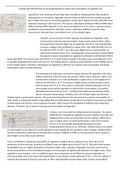Evaluate the effectiveness of tax being imposed to reduce the consumption of cigarettes 20)
Cigarettes is a de-merit good that brings fewer benefits to individuals than they would’ve
anticipated in a free market. Cigarettes may fail if they are left to the free market as people
don’t realise the costs of consuming cigarettes, as they don’t realise how they will suffer from
respiratory diseases in the long-term. This causes a divergence between MSB and MPB where
MSB is less than MPB. Quantity is at Q1 but social optimum is at Q* and Q1 is greater than Q*,
resulting in overconsumption. Therefore, there is allocative inefficiency are too many
resources are allocated here, and welfare loss is in the shaded region.
Taxation, such as excise tax, helps regulate consumption of cigarettes, a de-
merit good by reducing overconsumption, hence solves market failure. When
the government imposes higher tax on cigarettes, the firm’s cost of production
increases, making it less profitable to supply more. This shifts the MPC curve to
the left from MPC to MPC + tax. Firms pass higher prices to retain profits, so
price level increases from P1 to P2. Consequently, some consumers cannot afford
the good or reduce consumption of cigarettes so demand is at MSB there MSB is
lower than MPB. This reduces price level from P 2 to P* due to lower demand. This helps reach social optimum (P *Q*)
as quantity demanded decreases from Q1 to Q* and market failure is solved as social optimum is met. Welfare loss is
in the shaded region. Therefore, imposing tax on cigarettes is effective as it reduces overconsumption and brings
consumption down to social optimum.
The advantages of imposing a tax directly reduces demand for cigarettes, and solves
market failure but it also increases tax revenue. When a tax is imposed, a firm’s cost
of production increases, so it is less profitable to supply more, so the supply curve
shifts to the left from S1 to S2. Firms pass on higher prices to retain profits so price
level increases from P1 to P2. This causes a contraction along the demand curve as
more people cannot afford cigarettes or reduces their consumption, so quantity
demanded decreases from Q1 to Q*, reaching social optimum and solving market
failure. Consumer and producer incidence are in the shaded region and the total
shaded region is government revenue. The government hypothecate the tax revenue to promote consumption of
merit goods or goods with positive externalities that are alternatives of cigarettes to incentivise consumers to switch
to other goods and services, such as going to the gym, which reduces the possibility of suffering from respiratory
diseases. Therefore, tax is useful in reducing overconsumption of cigarettes.
Contrary, tax is not useful for reducing overconsumption. Tax can be
ineffective for cigarettes as cigarettes are price inelastic since they are
habitual goods so they are insensitive to price changes. When firms
pass on higher prices (to retain profit levels), price level increases
from P1 to P2 but quantity demanded decreases less than
proportionately from Q1 to Q2. Therefore, market failure is not solved
as consumption is not reduced to social optimum as most people are not sensitive to price changes. Market failure
has been reduced by a little but not enough due to a lower coefficient of PED, so the government has to impose a
much higher tax to reach social optimum.
Tax is not effective in reducing consumption of cigarettes as higher taxes is regressive tax. Since the cost of
production of firms increase, producers are likely to pass on higher prices (from P1 to P2). This harms low-income
households more as a higher proportion of income is taken. Also, majority of cigarette consumers are from low-
income households or from unemployed people, so most people are significantly affected from higher taxes. Since
cigarette is price inelastic, as it is an addictive good, most consumers are still likely to consume cigarettes so
overconsumption does not reduce and market failure is not solved as social optimum (P*Q*) is not met. Instead, it
worsens the standard of living of consumers as their real disposable income depreciates, as they cannot afford




